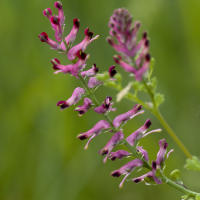Common fumitory
Fumaria officinalis
Introduction: Fumaria officinalis, commonly known as common fumitory or earth smoke, is an annual herbaceous plant belonging to the Papaveraceae family. Native to Europe, it has become widespread in many temperate regions across the world. Common fumitory has a long history of medicinal use and is recognized for its delicate, lacy appearance.
Identification: 1. Morphology:
- Height: Common fumitory typically grows to a height of 20 to 50 centimeters.
- Leaves: The finely divided, fern-like leaves give the plant a delicate appearance.
- Stems: Slender, branched stems bear clusters of small flowers.
2. Flowers:
- Inflorescence: The tiny, tubular flowers are pink to purplish in color and arranged in elongated racemes.
- Blooming Period: Common fumitory blooms from spring to early autumn.
3. Habitat:
- Found in a variety of habitats, including cultivated fields, gardens, waste areas, and disturbed soils.
- Prefers well-drained soils and is often associated with nitrogen-rich environments.
Ecological Roles:
1. Nitrogen Accumulation:
- Common fumitory, like many other members of the poppy family, can accumulate nitrogen in its tissues.
2. Beneficial to Insects:
- The flowers provide a food source for pollinators, including bees and butterflies.
Propagation and Growth:
1. Reproduction:
- Common fumitory reproduces through the dispersal of seeds.
- Seeds are small and are often spread by wind or via attachment to animals and human clothing.
2. Adaptability:
- The plant is well-adapted to disturbed areas and can thrive in a range of soil types.
Control in Gardens:
1. Cultural Practices:
- Maintaining healthy and dense vegetation in gardens can help suppress common fumitory growth.
- Regular cultivation and mulching may also be effective.
2. Herbicide Use:
- Selective herbicides targeting broadleaf weeds can be employed for control.
- Care must be taken to minimize the impact on desirable plants.









